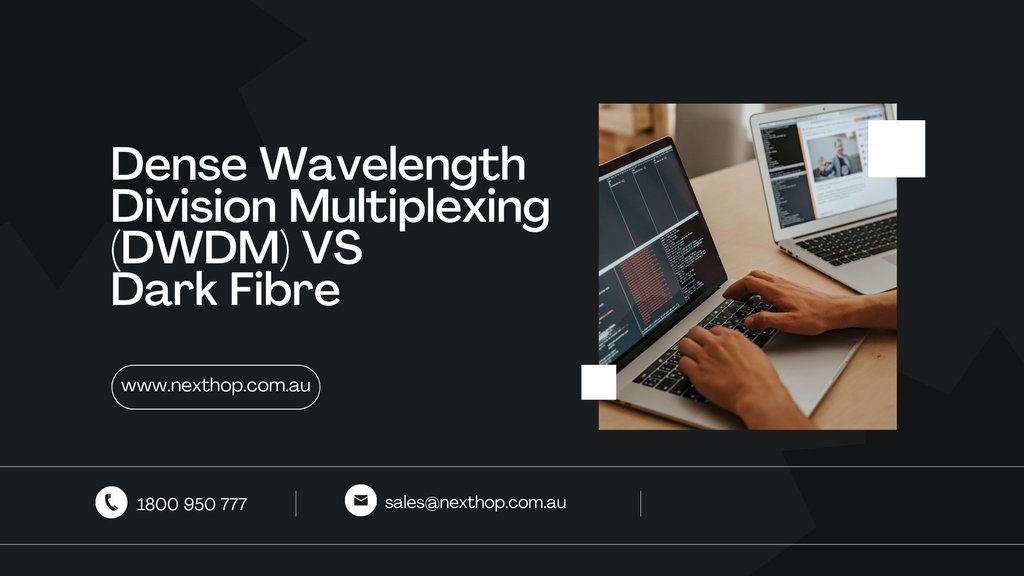In the ever-evolving landscape of telecommunications and data networking, businesses and service providers constantly seek efficient and cost-effective solutions to meet their growing bandwidth demands. Two prominent technologies that often come into consideration are Dense Wavelength Division Multiplexing (DWDM) and dark fibre. Both offer unique advantages and are suited to different needs. This article delves into the fundamentals, advantages, and considerations for choosing between DWDM and dark fibre.
Demystifying the Fundamentals
Dense Wavelength Division Multiplexing (DWDM)
DWDM is an advanced optical transmission technology that enables the transmission of multiple data streams simultaneously over a single optical fibre. This is achieved by using different wavelengths (or channels) of light to carry different data signals. Each wavelength operates at a different frequency, allowing multiple signals to coexist on the same fibre without interference. This technology significantly increases the capacity of existing fibre infrastructure without the need for laying additional cables, making it a highly scalable and efficient solution.
Dark Fiber
Dark fibre refers to unused or unlit optical fibre cables that have been laid but are not currently in use for data transmission. These fibres do not carry any data until the necessary equipment is installed at both ends to light them up and facilitate data transmission. Unlike DWDM, which leverages existing infrastructure, dark fibre requires additional investment in transmission equipment, such as transceivers and amplifiers, to become operational.
Key Difference
The primary difference between DWDM and dark fibre lies in their approach to utilizing fibre infrastructure. DWDM enhances the capacity of existing fibre networks by multiplexing multiple wavelengths over a single fibre , making it a more scalable and cost-effective solution for incremental bandwidth needs. In contrast, dark fibre involves deploying dedicated fibre strands, which requires a higher initial investment in equipment but offers unparalleled control and customization options.
Unveiling the Advantages of DWDM
Enhanced Scalability and Flexibility
One of the most significant advantages of DWDM is its scalability. As the demand for bandwidth increases, additional wavelengths can be added to the existing fibre infrastructure, allowing for seamless expansion without the need for new fibre cables. This scalability ensures that network growth can be managed efficiently and cost-effectively, making DWDM an attractive option for businesses with evolving bandwidth requirements.
Cost-Effectiveness (for Specific Scenarios)
DWDM can be particularly cost-effective for high-bandwidth users who require scalable solutions. By leveraging existing fibre infrastructure, DWDM minimizes the need for laying new cables, reducing capital expenditures. Additionally, the ability to add wavelengths incrementally allows businesses to pay for the capacity they need when they need it, optimizing operational expenses over time.
Managed Service Options
Another compelling advantage of DWDM is the availability of managed service options provided by network operators. These managed services encompass installation, maintenance, and network management, relieving businesses of the burden of handling complex DWDM equipment and operations. This allows organizations to focus on their core activities while ensuring their network infrastructure is managed efficiently and reliably by experts.
Exploring the Potential of Dark Fiber
Unmatched Bandwidth and Control
Dark fibre offers unparalleled bandwidth and control, as it involves deploying dedicated fibre strands exclusively for the user. This allows organizations to choose their own transmission equipment and configure the network to meet their specific needs. The flexibility to select the most suitable equipment and customize the network architecture ensures optimal performance and future-proofing.
Enhanced Security
Security is a paramount concern for many businesses, and dark fibre provides an added layer of protection. Since dark fibre consists of dedicated lines that are not shared with other users, the risk of data breaches and interception is significantly reduced. This exclusivity enhances the security of sensitive data transmissions, making dark fibre an ideal choice for organizations with stringent security requirements.
Cost-Efficiency (for Long-Term, High-Bandwidth Needs)
While the initial investment in dark fibre can be substantial, it can prove to be more cost-effective in the long run for users with very high bandwidth demands. Unlike leased fibre solutions, dark fibre eliminates recurring leasing fees, resulting in lower operational expenses over time. For businesses with sustained high-bandwidth needs, this cost-efficiency can justify the upfront investment in dark fibre infrastructure.
Making the Right Choice: DWDM vs. Dark Fiber
When deciding between DWDM and dark fibre, several key factors must be considered:
- Scalability Needs: If your organization anticipates gradual bandwidth growth and seeks a scalable solution, DWDM's ability to add wavelengths incrementally can be highly advantageous.
- Budget Constraints: DWDM can be more cost-effective for incremental bandwidth needs, while dark fibre requires a higher initial investment but can be more economical over time for very high-bandwidth users.
- Bandwidth Requirements: For extremely high bandwidth needs and total control over the network, dark fibre offers unmatched capacity and customization options.
- Security Considerations: If security is a top priority, dark fibre`s dedicated lines provide enhanced protection compared to shared DWDM infrastructure.
- Technical Expertise: Managing dark fibre requires technical expertise to handle the necessary equipment and network configuration. Organizations must assess their in-house capabilities or consider outsourcing to specialists.
Consulting with network specialists is highly recommended to assess your specific needs and determine the optimal solution. These experts can provide valuable insights into the most suitable technology based on your organization's requirements, ensuring you make an informed decision.
Conclusion
Choosing the right high-bandwidth network solution is crucial for meeting your organization's data transmission needs efficiently and cost-effectively. DWDM and dark fiber each offer unique advantages, and the decision between the two should be based on factors such as scalability, budget, bandwidth requirements, security, and technical expertise. By carefully evaluating these considerations and consulting with network specialists, you can select the solution that best aligns with your organization's objectives and future growth plans.
For organizations seeking unparalleled control, security, and bandwidth, dark fibre is an excellent choice. If you're considering implementing dark fibre to meet your high-bandwidth needs, Nexthop offers comprehensive dark fibre services tailored to your specific requirements. Our experts are ready to assist you in designing and deploying a robust and secure dark fibre network.
Contact Nexthop today to learn more about how our dark fibre solutions can enhance your network infrastructure and support your business growth.






